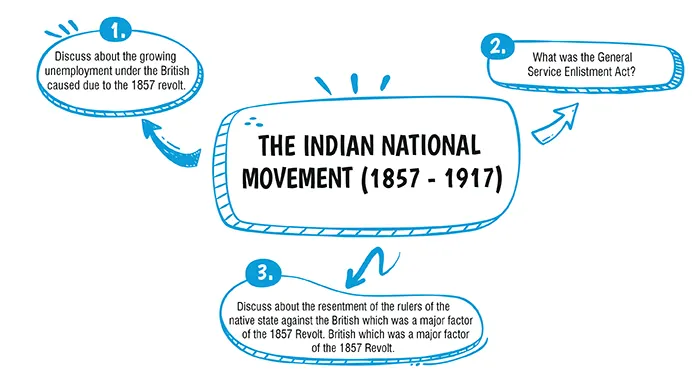

Here are some important class 10 The Indian National Movement (1857 - 1917) important questions and answers. These questions aim to aid students in practising and achieving high scores in their CBSE Class 10 Social Science Examination 2023-24. Diverse question types will assist in clarifying doubts and effective exam preparation, enhancing problem-solving skills, and building confidence. Class 10 The Indian National Movement (1857 - 1917) important questions and answers will be helpful in preparing well for exams.
The Indian National Movement from 1857 to 1917 marked a significant epoch in the history of India, embodying the relentless struggle for independence from British colonial rule. The period started with the fierce Sepoy Mutiny of 1857, also known as the First War of Independence. This unprecedented uprising, fueled by widespread discontent and resentment amongst the Indians against the oppressive policies and insensitivity of the British rulers, was a broad-based military and civil rebellion, although it eventually met with failure. These concepts are crucial when studying class 10 The Indian National Movement (1857 - 1917) important questions and answers.
The Indian National Movement from 1857 to 1917 marked a pivotal era in India's history, characterized by a fervent pursuit of independence from British colonial rule. Beginning with the Sepoy Mutiny in 1857, it evolved into a multifaceted struggle encompassing various ideologies and leaders. Figures like Mahatma Gandhi, Bal Gangadhar Tilak, and Dadabhai Naoroji emerged, advocating for self-governance, civil disobedience, and socio-political reforms. Movements like the Swadeshi Movement, the Non-Cooperation Movement, and the formation of the Indian National Congress (1885) served as pivotal moments, uniting Indians across regions and communities toward the common goal of liberation from British dominance, setting the stage for India's eventual independence in 1947.

Ans. (c)
Explanation:
Nana Saheb had inherited enormous wealth from the ex-Peshwa. He spent that money in sending emissaries to different parts of the country and instigating revolts everywhere.
Ans. (a)
Explanation:
The "General Committee of Public Instruction, 1823" was created to track the growth of education in India that was influenced by Orientalists who favoured Oriental education rather than the Anglican. They therefore created the pressure to support Western Education for the British India Company
Explanation:
Indian weavers and craftsmen could not compete with the machine-made goods of the British and thousands of weavers/craftsmen became unemployed. The demand for Indian textiles was reduced and the handloom industry was badly affected. The company used political influence to buy finest quality cotton from India. Annexation of Princely States led to loss of royal patronage. Thousands of soldiers lost their traditional jobs. This led to large scale unemployment.
Explanation:
In 1856, the General Service Enlistment Act was passed by the British Parliament. According to this Act, the Indian soldiers could be sent overseas. The Brahmin soldiers saw in it a slander to their caste. According to an accepted belief, it was considered a taboo for a Brahmin to cross the seas. This Act disregarded the feelings of the Indian troops, which led to a feeling of resentment among them. As a result, they were angry with the Britishers.
Explanation:
The last Mughal Emperor was Bahadur Shah. Lord Canning announced that Bahadur Shah’s successor would not be allowed to use the imperial titles. Such a discourtesy to the Mughal Emperor hurt Muslims’ sentiments considerably. Dalhousie’s refusal to grant pension to Nana Saheb, the adopted son of the ex-Peshwa (Baji Rao II) was resented by the Hindus in general and Nana Saheb in particular. Nawab Wazid Ali Shah was deposed on the ground that Awadh was not being managed well. The annexation of Awadh was a case of high-handedness on the part of the Company. The Nawab of Awadh had been loyal to the Company for a long time. The British broke all their pledges and promises to the native rulers. This all caused resentment among the rulers.


If you are looking to further practice and enhance your understanding of the concepts discussed in the chapter, oswal.io provides a comprehensive set of questions of ICSE Class 10 history important questions for understanding the concept in a better way.
Ans: The immediate cause of the Revolt of 1857 was the introduction of the new Enfield rifles in the British Indian Army, which required soldiers to bite off the paper cartridges greased with animal fat, offending both Hindu and Muslim soldiers.
Ans: Begum Hazrat Mahal, also known as the Begum of Awadh, led the Revolt of 1857 in Lucknow. She played a crucial role in organising and leading the rebellion against British rule in the region.
Ans: The Indian National Congress (INC) was formed to provide a common platform for Indians to voice their political demands and grievances against the British administration. It aimed to seek constitutional reforms that would grant a larger role in governance and administration to Indians.
Ans: The All India Muslim League was founded in 1906 by Aga Khan, Nawab Salimullah of Dhaka, and others. It was established to safeguard the political rights and interests of the Muslims in India and to promote loyalty to the British government.
Ans: The official reason given for the Partition of Bengal by Viceroy Lord Curzon was administrative efficiency. However, it was widely believed that the real motive was to divide and rule by creating a religious divide between Hindus and Muslims.